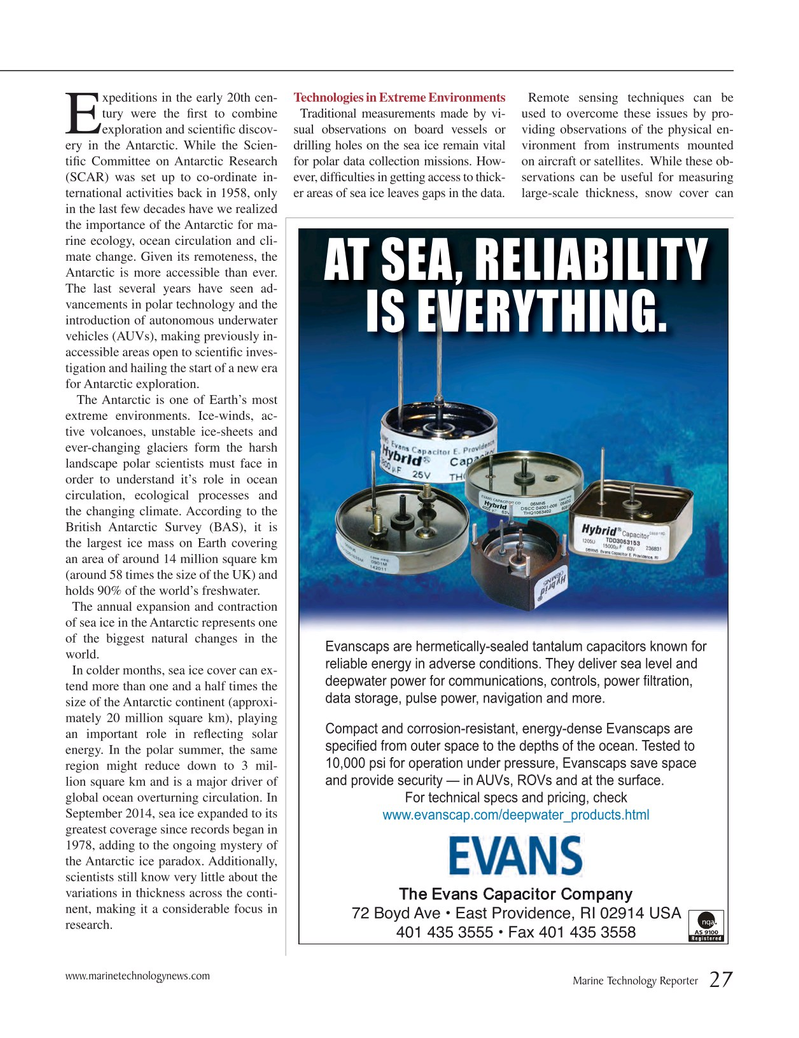
Page 27: of Marine Technology Magazine (January 2015)
Underwater Vehicle Annual: ROV, AUV, and UUVs
Read this page in Pdf, Flash or Html5 edition of January 2015 Marine Technology Magazine
xpeditions in the early 20th cen- Technologies in Extreme Environments Remote sensing techniques can be tury were the ? rst to combine Traditional measurements made by vi- used to overcome these issues by pro-
Eexploration and scienti? c discov- sual observations on board vessels or viding observations of the physical en- ery in the Antarctic. While the Scien- drilling holes on the sea ice remain vital vironment from instruments mounted ti? c Committee on Antarctic Research for polar data collection missions. How- on aircraft or satellites. While these ob- (SCAR) was set up to co-ordinate in- ever, dif? culties in getting access to thick- servations can be useful for measuring ternational activities back in 1958, only er areas of sea ice leaves gaps in the data. large-scale thickness, snow cover can in the last few decades have we realized the importance of the Antarctic for ma- rine ecology, ocean circulation and cli- mate change. Given its remoteness, the
Antarctic is more accessible than ever.
AT SEA, RELIABILITY
The last several years have seen ad- vancements in polar technology and the introduction of autonomous underwater
IS EVERYTHING.
vehicles (AUVs), making previously in- accessible areas open to scienti? c inves- tigation and hailing the start of a new era for Antarctic exploration.
The Antarctic is one of Earth’s most extreme environments. Ice-winds, ac- tive volcanoes, unstable ice-sheets and ever-changing glaciers form the harsh landscape polar scientists must face in order to understand it’s role in ocean circulation, ecological processes and the changing climate. According to the
British Antarctic Survey (BAS), it is the largest ice mass on Earth covering an area of around 14 million square km (around 58 times the size of the UK) and holds 90% of the world’s freshwater.
The annual expansion and contraction of sea ice in the Antarctic represents one of the biggest natural changes in the
Evanscaps are hermetically-sealed tantalum capacitors known for world. reliable energy in adverse conditions. They deliver sea level and
In colder months, sea ice cover can ex-
GHHSZDWHUSRZHUIRUFRPPXQLFDWLRQVFRQWUROVSRZHUÀOWUDWLRQ tend more than one and a half times the data storage, pulse power, navigation and more.
size of the Antarctic continent (approxi- mately 20 million square km), playing
Compact and corrosion-resistant, energy-dense Evanscaps are an important role in re? ecting solar
VSHFLÀHGIURPRXWHUVSDFHWRWKHGHSWKVRIWKHRFHDQ7HVWHGWR energy. In the polar summer, the same 10,000 psi for operation under pressure, Evanscaps save space region might reduce down to 3 mil- and provide security — in AUVs, ROVs and at the surface. lion square km and is a major driver of global ocean overturning circulation. In
For technical specs and pricing, check
September 2014, sea ice expanded to its www.evanscap.com/deepwater_products.html greatest coverage since records began in 1978, adding to the ongoing mystery of the Antarctic ice paradox. Additionally, scientists still know very little about the variations in thickness across the conti-
The Evans Capacitor Company nent, making it a considerable focus in %R\G$YH?(DVW3URYLGHQFH5,86$ research.
?)D[ www.marinetechnologynews.com
Marine Technology Reporter 27
MTR #1 (18-33).indd 27 MTR #1 (18-33).indd 27 2/2/2015 3:18:06 PM2/2/2015 3:18:06 PM

 26
26

 28
28
